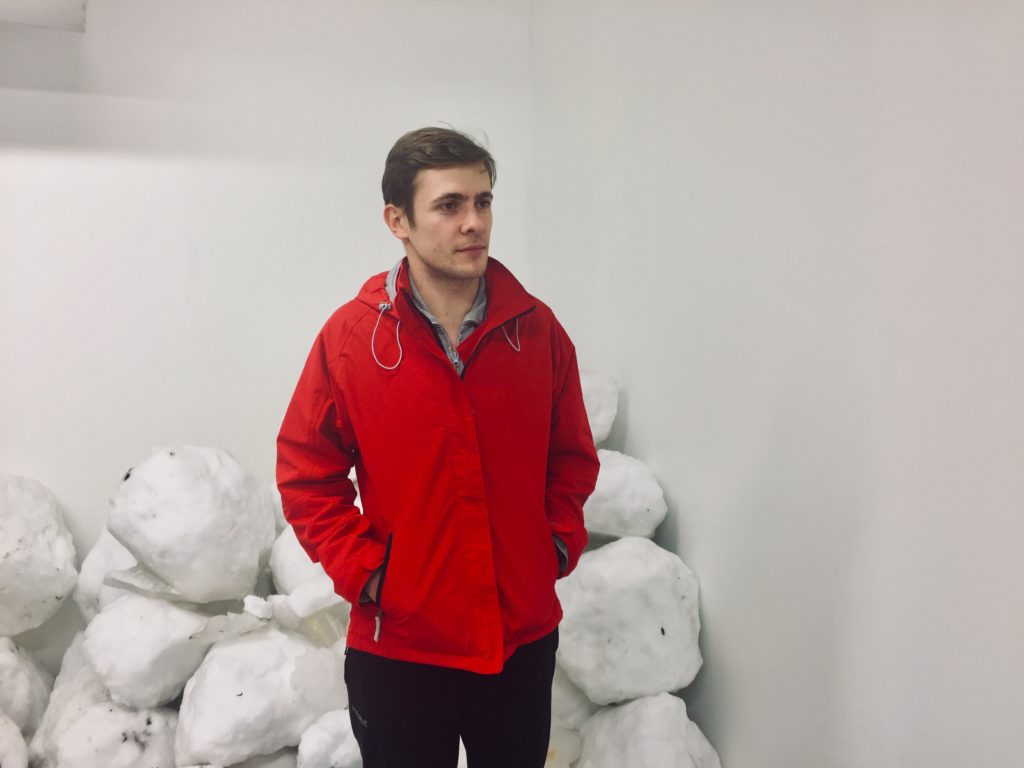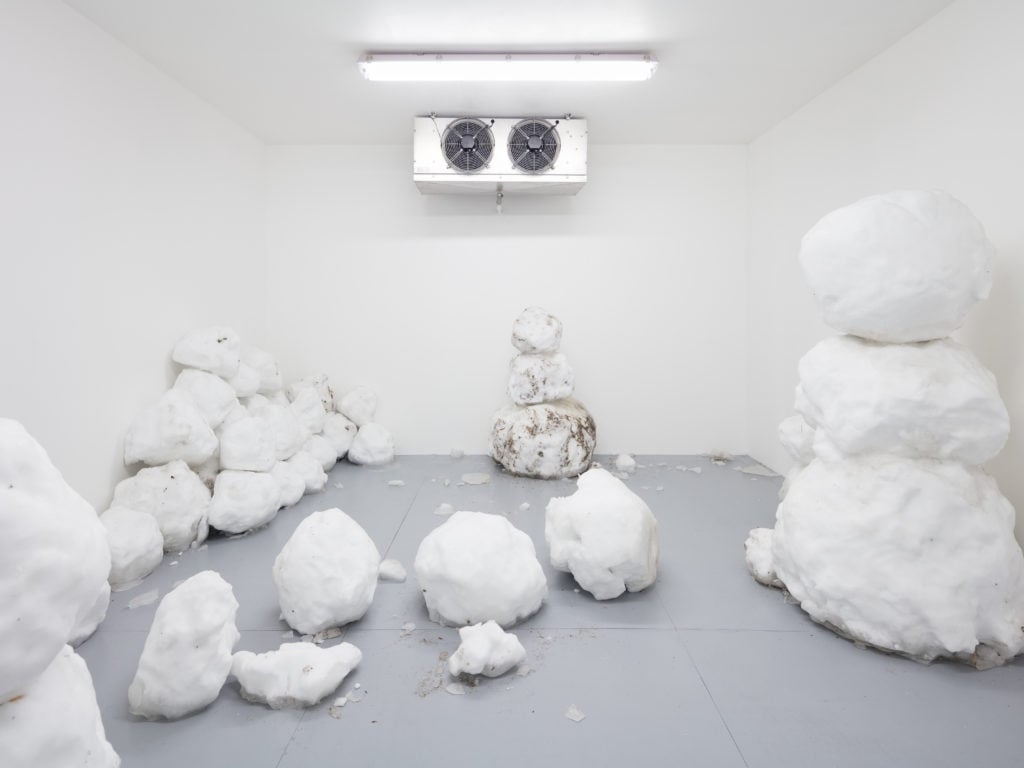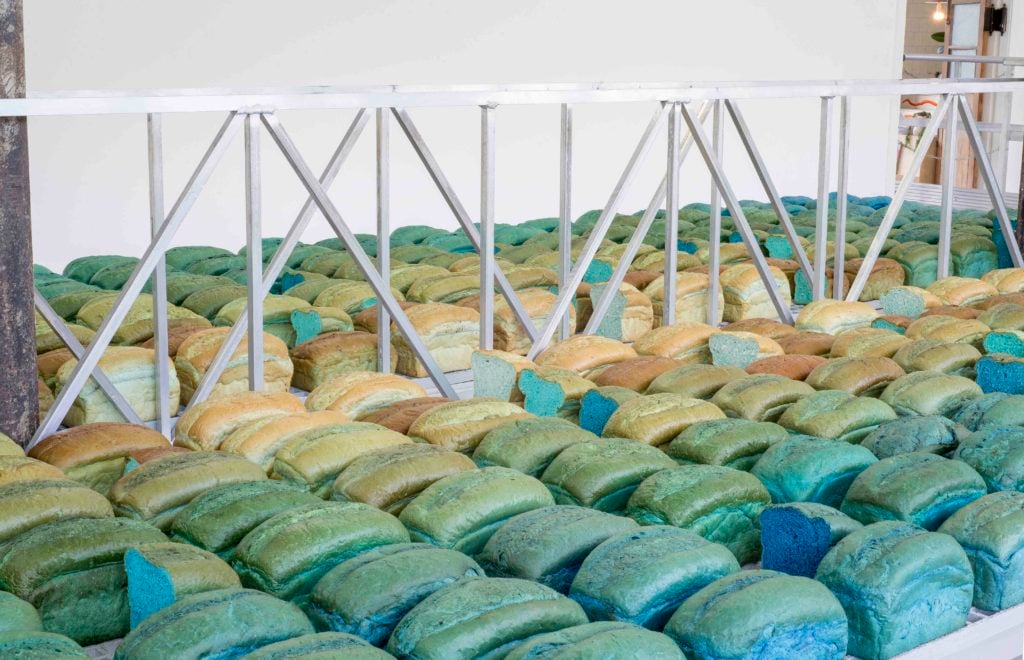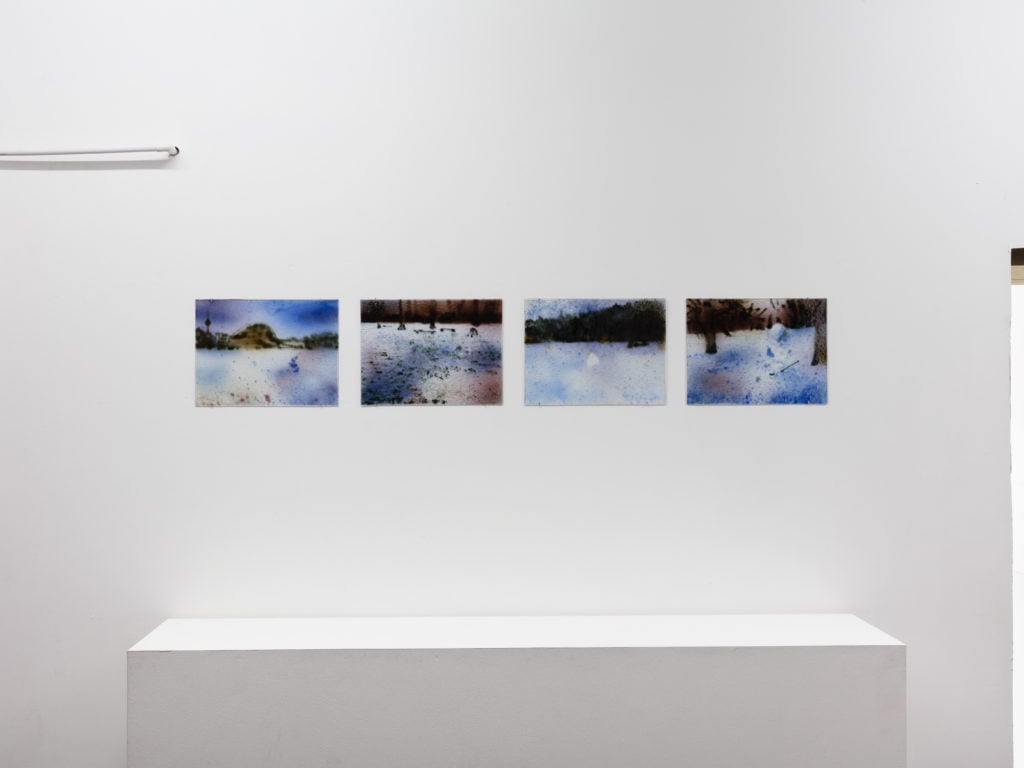People
Meet Augustas Serapinas, the Youngest Artist in the Venice Biennale, Who Likes to Lure Curators Into an Empty Sewer
The 28-year-old artist is taking Venice—and the art world—by storm with his interactive, deeply humane installations.

The 28-year-old artist is taking Venice—and the art world—by storm with his interactive, deeply humane installations.

I get goosebumps when I first meet Augustas Serapinas. The young artist does have somewhat disarming brown eyes, but the more likely cause of the chill is all the snow around us. He is installing a number of snowmen as part of a new show at Emalin, a hip East London gallery in Shoreditch.
Dressed in a red windbreaker and sweatpants, Serapinas smiles quietly as he invites me into a large fridge where he is keeping the snowman pieces he tells me he has “rescued” from playgrounds around his home city of Vilnius, Lithuania.
The snow is an amusing foil to the first show he had at the gallery when it debuted in 2016; he created a fully-functioning sauna to celebrate the housewarming. Three years later, Serapinas is gearing up for his most prominent project to date: participation in the main exhibition at the Venice Biennale. It’s a prestigious gig for any artist, but especially for the 28-year-old, who is the youngest one to make the cut.
The artists included in the biennale’s main event offer a slice of the contemporary zeitgeist and often influence curators for years to come. It’s not difficult to imagine Serapinas becoming the breakout star. He serves as a kind of thinking man’s successor to both the “relational aesthetics” movement of the ’90s, which posited that audience interaction could constitute art, and the fetish for Instagram-ready “experiences” of the 2010s, which maintains that the best art is an immersive installation you can step into (and take pictures of).
Serapinas’s work, on the other hand, is interactive and immersive—but it also “extends to peoples beyond those present in the gallery, and his installations are not structured as events,” curator Caroline Elbaor explains.
The artistic director of this year’s biennale, Ralph Rugoff, first met Serapinas at the Vilnius chapter of the Baltic Triennial. The artist cemented himself in Rugoff’s mind when he invited him to come along on an unforgettable studio visit.
It’s hard to picture the esteemed curator donning gumboots and following the artist, Ninja Turtle-style, into an old drainage pipe somewhere along the Vilnia River, but so it went. Serapinas takes an unusual approach to studio visits in order to circumvent the fact that he doesn’t have a traditional studio space. Most of the work he makes is site-specific, so he invites visitors to discuss his practice inside his favorite spot in the sewer.
Hi Instagram ✌ Greetings from The Iluminator ??
A post shared by Augustas Serapinas (@augustasserapinas) on
Rugoff is just one of a whole gang of international curators who have made the pilgrimage, including Kunsthalle Wien director Nicolaus Schafhausen and Anders Kreuger, senior curator at the MHK Antwerp. All were sufficiently impressed that they went on to work with the artist.
Rugoff describes being in the artist’s secret hideout, which exists somewhere in between the public and private realm, as a “mind-altering” experience. Artists who occupy interstitial spaces—both in this literal sense, and those whose work defies easy categorization—will be a running theme of the biennale’s main exhibition, “May You Live in Interesting Times.”
Serapinas is certainly interesting enough. Rugoff says that while the artist might “technically” be the youngest in his show, there are plenty of others in the same ballpark (29 of the 79 were born in the ‘80s). For his part, the artist says that age is just “a fact game” that doesn’t correspond with reality. “Do I feel young?” he asks. “Maybe I did back in 2013 when I had just graduated, but I’m more experienced now.”
Born in 1990, Serapinas was raised in Vilnius by his Russian mother and his Lithuanian father, who met in Russia but moved back to Lithuania in 1988, before the collapse of the Soviet Union. Growing up, he says he struggled to come to terms with his “in-between” identity, speaking Russian with his parents at home, but never feeling that he fully fit the criteria for either national identity.
As we sip oat milk lattes in a hipster coffee shop near the gallery, Serapinas recalls his family’s frugal lifestyle. His father was an Orthodox priest and they couldn’t afford a television until he was around eight years old. The two times a year they ate chicken (Easter and Christmas) were a special treat. “But a lot of people live like that,” the artist hastens to clarify. “It’s not a rough environment.”

Installation view “February 13” (2019). Courtesy of the artist and Emalin, London. Photography by Plastiques.
They grew more affluent as he got older, although he explains (rather pointedly) that education and healthcare are “free and equal” for everyone in Lithuania. His school days were spent at an arts-focused institution, the National M.K. Ciurlionis School of Art, and he learned to speak English working summer jobs from 18 to 21 on building sites in London. It was grueling work, requiring a 4 a.m. start time and a tough constitution. “I didn’t know how to do anything so I always got the shittiest jobs,” Serapinas explains. (He means that quite literally: cleaning toilets was among his tasks.)
But the hard work taught him a valuable lesson. “It’s important to know what you don’t want to do,” he explains. “Finding this out leads you to something you do want, and the sooner you find that out, the better it is for you psychologically.”
Ultimately, he set out to earn a BA in sculpture from the Vilnius Academy of Arts. After finishing college in 2013, he spent some time at the Rupert Educational Program in Vilnius, which is run by his wife, Justė Jonutytė, with whom he has a two-year-old son, Vincas.
Creating secret and in-between spaces is a recurring theme for Serapinas. “I like to use the space that is right next to you but you don’t think about,” the artist explains.
For the sixth Moscow Biennale, he created a secret tearoom hidden behind a painting by one of the other participating artists. After a 2014 residency the MHK A, he demolished a wall to make a behind-the-scenes crawl space accessible to the public. The institution’s Swedish senior curator Anders Kreuger had scouted Serapinas in late 2013. “Augustas is very dedicated and hard-working, and also both smart and charming,” Kreuger tells me. “Not a bad combination of qualities for an ambitious young artist!”
Serapinas explains that his approach to art-making is somewhat improvisational. “I’m an artist but I’m not an artist,” he says. “For me every show is a problem and I need to solve it.” He often begins a project by talking to the people who live next door to the site. These encounters often enrich the work and help him crack the art-world bubble. For the sauna he created at Emalin, for example, he cast the door handle, bucket, and other objects from melted-down keys salvaged from the locksmith next door.

Augustas Serapinas, Blue Pen (2018). Courtesy of the artist and David Dale Gallery, Glasgow.
Another installation at David Dale Gallery in Glasgow was based on an anecdote he heard from one of the workers at the neighboring ladder factory. After completing a project at a commercial bakery some 40 years earlier, someone accidentally dropped a blue pen into one of the mixers, and around 10,000 loaves had to be taken out of production as a result. Serapinas gave form to this oral history by recreating the moment, blue loaves and all. “My work is really about the relations between people,” he explains.
“Augustas is an old soul with endless curiosity for the people and material histories in the world around him,” London-based writer and editor Arielle Bier, a friend of the artist, tells me. “This comes through in every element of how he functions in the world.”
As you might imagine, Serapinas’s work—site-specific, experiential—”doesn’t lend itself to being commercial,” his gallerist Leopold Thun confirms in a rather relaxed manner for someone involved in the high-stakes business of art. “I admire it a lot that he doesn’t really compromise in order to make commodities or sell-able artworks.”
Thun discovered Serapinas when he was still a student himself, and despite the limited marketability of the work, he was the first artist Emalin picked up when the gallery launched in 2016. The decision paid off quickly for both parties. Serapinas managed to secure his first bona fide art sale even before his gallery debut, when Nicoletta Fiorucci of the Fiorucci Art Trust invited him to make a site-specific work. And on the last day of his inaugural exhibition at the gallery, the Russian V-A-C Foundation snapped up the metal objects from the sauna installation.

Installation view “February 13” (2019). Courtesy of the artist and Emalin, London. Photography by Plastiques.
In recent years, more physical objects have emerged from his practice; he makes stained-glass windows and bits and pieces that outlive his installations (such as the sauna objects). Emalin shares representation of the artist with Apalazzo Gallery in Brescia, Italy, which Thun says is particularly helpful as many of his installations can be “monetarily demanding.”
Being included in the Venice Biennale is a career-defining achievement, but Serapinas isn’t about to get complacent. “I never had this moment where I have thought ‘I have made it,’” he says. “No, if you think like this, you’re dead.” He views his artistic career as an endurance test, not a sprint, and he is blasé about the recognition: “Venice is just a show…”
While it’s easy to be seduced by the art world when you’re young (and he says he’d be lying if he claimed not to enjoy some of the perks, as well as the security success brings his family), there’s more to life than what’s in your bank account. “Attention and money might help you at certain moments to feel more confident, but I’ve met a lot of rich people and I know money does not bring you happiness,” he says.
“I’m glad I can live and do what I want. Sometimes I wake up in the morning and I’m so happy that I don’t have to go anywhere. No school, no building sites…I can just do nothing, if that’s what I want.”
Under strict instructions from the biennale’s organizers, Serapinas kept tight-lipped about what he has in store for Venice. He would divulge only that the two works he will present—one brand new, one from 2018—are very different, but both relate to people. His gallerist would let slip only that the new work may have something to do with docents.
When I speculated that Serapinas might be involved in some of the “architectural interventions” Rugoff has promised for the Arsenale, the gallerist cautioned: “Never underestimate health and safety at huge massive events. It can be a real stick in the wheels.” One thing is certain, however: for an artist who feels at home in fridges and cement pipes, the beautiful renaissance backdrop of Venice will offer ample opportunity for iconoclasm.